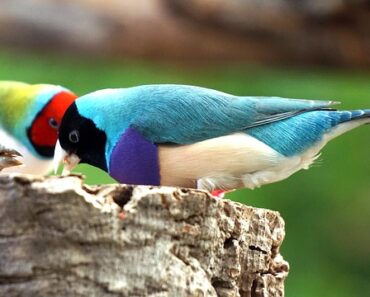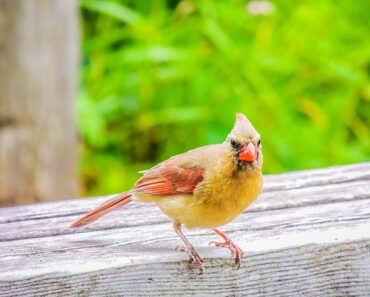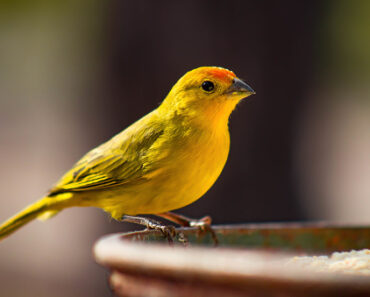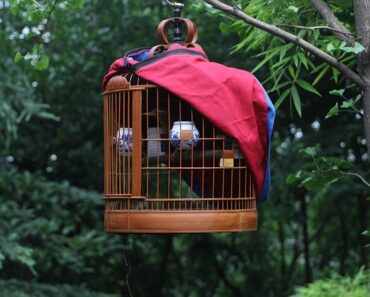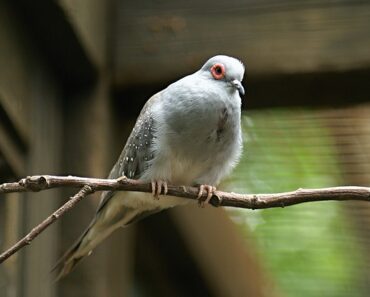
The Mandarin Diamond is a beautiful passerine, dynamic and very pleasant. It is very easy to domesticate and reproduces easily in captivity. He needs a well-equipped cage to live happily, and his master must take care of his health because he is sensitive to various problems. Let’s discover together who the Mandarin is and what his needs are.
The Mandarin Diamond: main characteristics
The Mandarin Diamond (Taeniopygia guttata) is a bird that belongs to the family Estrildidae and the order Passeriformes. This passerine, very familiar in central Australia, is frequently referred to as Mandarin. It is a bird that does not live in isolation, but in a group of several pairs. It is therefore said to adopt a gregarious behavior.
It lives mainly in the steppe where it can take shelter in trees or shrubs. But since a few years, it is quite frequently observed in all Australian cities. It has gradually acclimatized to the presence of humans as well as to the various disturbances of its habitat by humans such as deforestation for example, which has led to many open spaces.
Its life expectancy in the wild is 5 years and in captivity it can reach about ten years.
When it is young, this bird has pinkish legs and a black beak that changes color upon entering adulthood as they become reddish-orange. Sexual dimorphism is then very marked since the male in the wild state is distinguished from the female by its reddish white flanks, orange cheeks, stripes on the chest. The female is more greyish.
However, there are nowadays many mutations due to countless crosses, so that we can observe mixed brown, white plumage, black-cheeked or without any pattern, black or orange-breasted farmed Mandarins. We can even sometimes find curly or crested domestic Mandarins.
At adulthood, the wild Mandarin Diamond measures about ten centimeters for a feather weight of 15 g at the most. But mutations can also concern the size of the passerines, and the domestic shape is slightly larger.
Greater Mandarin Diamond : reproduction
Once they form a couple, the male and female do not separate except when one has to guard the nest while the other takes care of the search for food. Only the male sings, while the female only makes nasal cries.
In the wild, a couple of Mandarin can have young at any time of the year, although the mating season always takes place between late March and early June. This passerine adapts and uses any type of nest such as a bush, a tree hole or a cavity in a wall, a rabbit hole, a cave and even a termite nest…
After mating, the female usually lays between 4 and 6 eggs, very exceptionally 10. The two parents alternate to incubate their eggs. Incubation lasts 15 days. The chicks are fed by their father and mother for 3 weeks, after which they leave the nest.
Breed a Mandarin Diamond
Under French law, only the domesticated Mandarin Diamond from breeding is considered as a domestic animal.
Here are the points to be respected when breeding Mandarin Diamonds.
A very endearing bird easy to tame
This very sociable and lively bird, full of dynamism, is rather talkative, both with its fellow birds and with humans. Attaching, it is very appreciated because it is easy to raise but also to tame. It is therefore perfectly suitable for amateur breeders. You can buy it in most pet stores where it is very commonly sold. It is recommended to buy one or more couples rather than a single bird. Different types of mandarins allow you to have afterwards little ones in various colors. But be careful to choose only males and females without any family ties.
A well equipped cage is enough
One can offer his Mandarins an aviary, but a reasonably sized breeding cage is more than enough. On the other hand, it must be well equipped. Therefore, perches made of branches – rather than plastic perches -, feeders and waterers should be installed. You should also think about equipping the cage with a small bathtub, because these birds love to take care of themselves and they also like to have fun, so we recommend putting two or three play mirrors in their environment.
Installation of the nest
Don’t forget to add a nest in the cage of the Mandarin Diamond, where it can rest overnight and later raise its chicks. The nest, which must be intimate enough, should be hung high up. It should not be touched once the eggs have been laid. The slightest disturbance of the couple during the whole incubation period can lead to the abandonment of the eggs. The Mandarin Diamond can even throw them out of the nest and eat them. It can also abandon its chicks if it feels threatened.
An adapted diet
To feed its mandarin breeding, it is very important to give them an adapted food, of very good quality and perfectly balanced. These passerines need insects, especially during the reproduction period. We can give them an insectivore reproduction paste as well as a mixture of seeds for Diamond Mandarin. To meet its needs in vitamins, minerals and trace elements, one completes its daily ration with fresh fruits and vegetables (apple, pear, cabbage leaves, soy sprouts, cucumber, endive, spinach, chard, arugula …). Finally, we take care to put cuttlefish bones rich in calcium in the cage. As for the water in the drinking troughs, it must always be fresh.
Hygiene of the cage and health of the Mandarin Diamond
To take care of the health of its mandarin diamonds, the hygiene of the cage and all the accessories must be irreproachable to avoid cases of blepharitis often due to staphylococcus and conjunctivitis. Sensitive to mites and lice, this passerine does need to bathe daily in clean water, and the water used for drinking must also be changed often.
If one wishes to raise mandarin diamonds, one should be aware that their health must be monitored very closely. Good husbandry practice involves balancing one’s diet to avoid anemia, enteritis, constipation and inflammation of the cloaca, which is also caused by stress. In addition, regular deworming is necessary to limit the risk of intestinal parasites such as worms.
Finally, females sometimes have a belly that swells when they lay their eggs. Do not hesitate to massage this abdominal area to help expel an egg that may be stuck. If despite massaging, no improvement is noticed in the following hours, an emergency consultation with the veterinarian is required.

